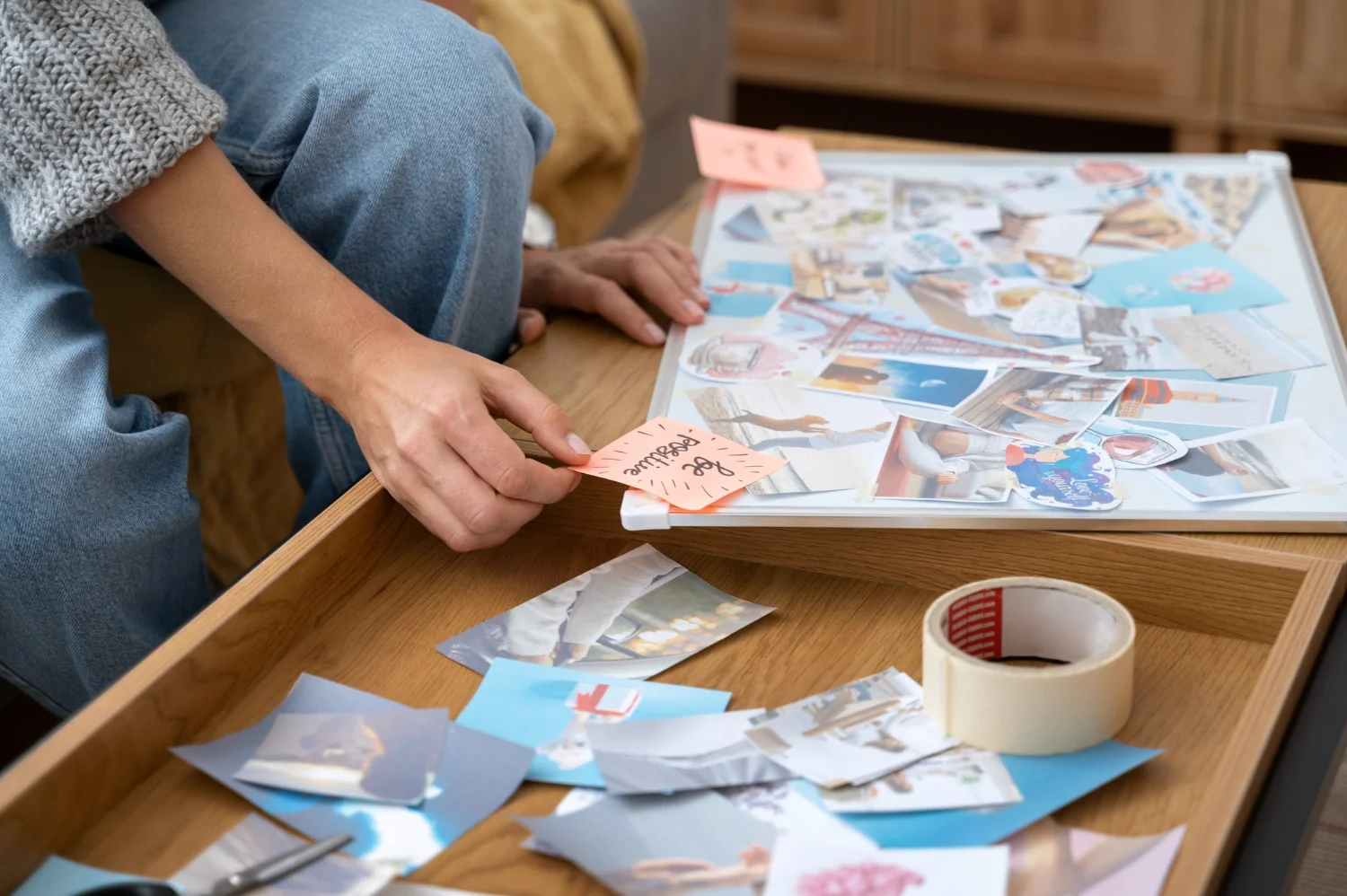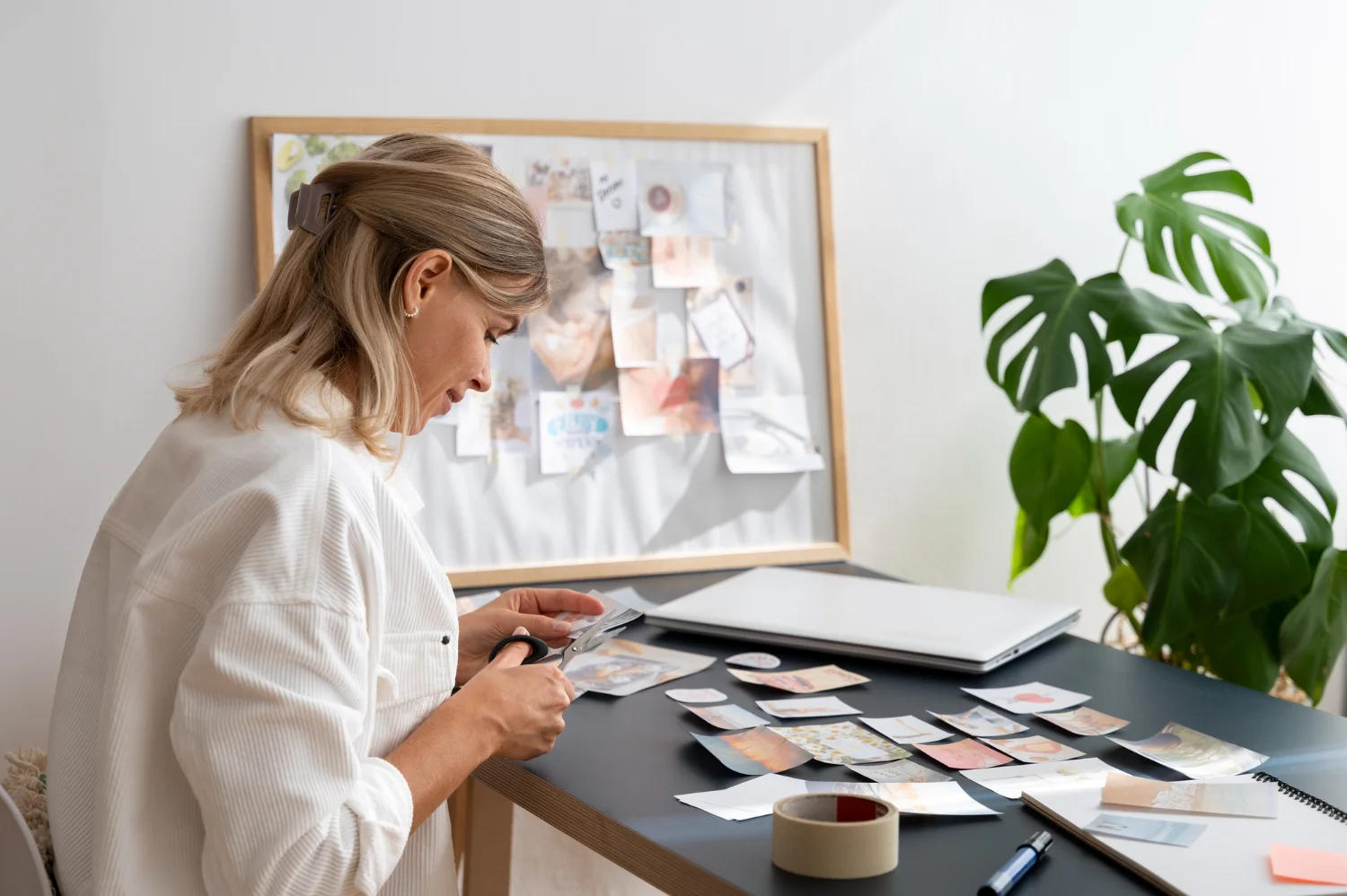
My first vision board looked like a Pinterest explosion happened on poster board. My second one was so vague it could have belonged to literally anyone on the planet. And don’t even get me started on the one I made during my “I’m going to manifest a million dollars” phase. Spoiler alert, I did not manifest a million dollars.
But here’s the thing, making mistakes is how you figure out what actually works. And since I’ve already embarrassed myself for science, I figured I’d share the biggest vision board fails so you don’t have to learn them the hard way like I did.
Because honestly, there are some mistakes that’ll kill your vision board dreams before they even get started. And I refuse to let that happen to you.
Mistake #1: Trying to Plan Your Entire Life at Once
This was me, three years ago, sitting on my living room floor with seventeen magazines and the delusion that I could somehow map out every aspect of my existence on one piece of poster board.
I wanted career success, and a perfect relationship, and financial freedom, and six-pack abs, and to speak fluent French, and to travel to every country, and to learn guitar, and to start a garden, and probably achieve world peace while I was at it.
The result? A vision board that looked like a tornado hit a magazine stand. It was overwhelming to look at, impossible to focus on, and honestly kind of stressed me out every time I walked past it.
What to do instead: Pick 3-5 main areas max. Like, maybe career and health and travel. Or relationships and money and personal growth. You get the idea. Your vision board should inspire you, not give you anxiety about how much you’re not doing.
Real example: My friend Sarah tried to include everything from “learn to cook” to “run a marathon” to “buy a house” on her first board. Six months later, she hadn’t made progress on anything because she didn’t know where to focus first. When she made a new board with just health and career goals, she actually started meal prepping and signed up for that certification course she’d been putting off.
Mistake #2: Making It Too Vague

“I want to be happy.” “I want success.” “I want love.” Cool, great, so does literally every human being on the planet. But what does that actually mean for YOU?
I spent months staring at a vision board that had the word “SUCCESS” in giant letters and a stock photo of someone in a business suit pointing at a graph. And I wondered why I felt zero motivation to actually work toward anything specific.
The problem: Your brain needs something concrete to work toward. “Happiness” isn’t a destination, it’s not something you can take action on. But “feeling confident enough to speak up in meetings” or “having Sunday mornings that feel peaceful and relaxed”? Those are things your brain can actually picture and plan for.
How to fix it: Get stupid specific. Instead of “financial freedom,” think “having $10,000 in my savings account and not panicking when I pay rent.” Instead of “better health,” think “being able to walk up three flights of stairs without feeling like I’m dying.”
Personal confession: I had “find love” on my vision board for two years. TWO YEARS. And I wondered why nothing was happening. Then I got specific about what kind of relationship I actually wanted, what qualities mattered to me, how I wanted to feel with a partner. Six months later, I met my current boyfriend. Coincidence? Maybe. But I’m not taking any chances.
Mistake #3: Putting Other People’s Dreams on Your Board
This one’s sneaky because you might not even realize you’re doing it. You see this gorgeous image of someone rock climbing, and you think, “Yeah, I want adventure in my life!” So you put it on your board.
But here’s the thing, you actually hate heights. And bugs. And being dirty. What you really want is to feel brave and accomplished, not necessarily to dangle off a cliff face.
How it happens: Social media makes everything look amazing. Your friend posts about their yoga retreat, your coworker talks about their side hustle, your sister seems to have her whole life together. And suddenly their goals start looking like your goals.
The reality check: Ask yourself, “Do I actually want this, or do I want the feeling I think this will give me?” There’s nothing wrong with wanting to feel adventurous, but maybe your version of adventure is trying new restaurants or taking a different route to work.
My embarrassing example: I put images of marathon runners on my vision board because it looked so inspiring and accomplished. Spent six months forcing myself to run and hating every second of it. Turns out, I don’t actually want to run marathons. I wanted to feel strong and disciplined. Now I do yoga and lift weights, and I’m way happier.
Mistake #4: Making It Too Perfect
Oh, this one hurts because it’s so me. I spent HOURS on my second vision board. Like, hours. Measuring spaces, making sure everything was aligned, choosing the perfect font for my inspiring quotes.
It was beautiful. It was also completely sterile and didn’t make me feel anything when I looked at it.
Why perfection kills vision boards: When you spend more time worrying about how it looks than what it means, you’ve missed the entire point. Vision boards are supposed to be personal and emotional, not gallery-worthy art pieces.
The perfectionist trap: You get so focused on the “right” images and the “best” layout that you forget to include the messy, weird, specific things you actually want.
Better approach: Done is better than perfect. Always. A wonky, heartfelt vision board will serve you way better than a pristine one that took you three weeks to make and doesn’t actually reflect your real desires.
Mistake #5: Forgetting It Exists After You Make It

Guilty as charged on this one. Made a gorgeous vision board, hung it up with pride, looked at it for maybe a week, and then it became part of the wallpaper. Just another thing on my wall that I stopped seeing.
The out-of-sight problem: If your vision board is tucked away somewhere you never go, or if you stop paying attention to it after the initial excitement wears off, it’s basically just expensive wall decoration.
What actually works: Put it somewhere you’ll see it regularly, even if that’s not the most aesthetically pleasing spot. Bathroom mirror, inside your closet door, next to your coffee maker. Function over form, always.
The maintenance factor: Set a reminder on your phone to actually look at your vision board. Sounds silly, but I promise it works. Every Sunday morning with my coffee, I spend five minutes looking at mine and thinking about what actions I can take that week.
Mistake #6: Never Updating It
Life changes. Goals evolve. What excited you six months ago might feel stale or irrelevant now. But somehow, we think our vision boards should be permanent fixtures, never to be touched or changed.
Why this matters: A vision board that doesn’t grow with you becomes meaningless. I had the same travel images on mine for over a year, even after I’d already taken two of those trips. Looking at pictures of places I’d already been wasn’t exactly motivating me toward new adventures.
The update rule: Every few months, take a honest look at your board. What still makes you excited? What feels old or irrelevant? What new dreams have shown up in your life?
Permission granted: You’re allowed to change your mind about your goals. You’re allowed to realize that thing you thought you wanted isn’t actually for you. Your vision board should reflect where you are now, not where you were when you first made it.
Mistake #7: Using Only “Aspirational” Images
Stock photos of people in business suits. Generic inspirational quotes in fancy fonts. Images so polished they could be in a catalog.
Here’s what I learned, those perfect, aspirational images don’t actually inspire me. They make me feel like my real life is messy and inadequate in comparison.
What works better: Real images of real life. Photos of actual people doing things you want to do. Screenshots of Instagram posts that made you think “I want that energy.” Pictures of your friends living in ways you admire.
Personal example: Instead of a stock photo of a perfect kitchen, I used a picture my friend posted of her making cookies with her kids. It was messy and chaotic and beautiful, and it made me excited about the idea of having a home where people wanted to hang out and bake things.
The authenticity factor: Your vision board should feel like YOUR life amplified, not someone else’s highlight reel.
Mistake #8: Focusing Only on Stuff, Not Feelings
My first vision board was basically a shopping list. A car, a house, clothes, gadgets, vacation destinations. All things, no feelings.
And you know what? Even when I got some of those things, I didn’t feel the way I thought I would. Because I’d been focused on the wrong part of the equation.
The real goal: It’s not actually about the stuff. It’s about how you want to feel in your life. Confident, peaceful, adventurous, connected, whatever. The stuff is just one possible way to get those feelings.
How to shift focus: For every material thing on your board, ask yourself, “How do I think this will make me feel?” Then look for images that capture that feeling directly.
Example flip: Instead of a picture of a fancy car, maybe you want an image of someone who looks free and confident. Instead of a dream house, maybe you want a picture that captures the feeling of “home” and safety.
Mistake #9: Making It Too Serious and Intense
Vision boards don’t have to be all deep and meaningful and life-changing. Sometimes you just want to remember that you’d like to learn how to make really good tacos, or that it would be fun to have plants that don’t die immediately.
The pressure trap: Thinking every goal on your vision board has to be profound and important. That’s exhausting and also not true.
Permission to be silly: Put weird stuff on there. Fun stuff. Small stuff. The goal that makes you smile even though it’s kind of ridiculous.
My silly goals: I have a picture of a really well-organized spice rack on my current vision board. Is it life-changing? No. Does it make me happy when I think about having my cooking supplies actually sorted? Absolutely.
Mistake #10: Expecting It to Do All the Work
This is the big one. Making a vision board and then sitting back waiting for the universe to deliver everything on it without you having to actually DO anything.
Reality check: Vision boards aren’t magic. They’re tools for clarity and motivation. They help you remember what you’re working toward and why you care about it. But you still have to, you know, work toward it.
The action connection: The most successful vision board experiences I’ve had were when I used the board to inspire specific actions. Seeing my travel goals reminded me to research flights and save money. Looking at my health images motivated me to actually book that doctor’s appointment I’d been putting off.
What vision boards actually do: They keep your goals visible instead of buried in the back of your mind. They help you notice opportunities related to your goals. They remind you to take action when motivation is low.
What they don’t do: Make things happen without your participation. Guarantee specific outcomes. Work if you completely ignore them after making them.
The Real Secret to Vision Boards That Work
After making approximately seventeen vision boards over the past few years, and learning from all these mistakes the hard way, here’s what I’ve figured out.
The best vision boards are personal, specific, authentic, and flexible. They reflect what YOU actually want, not what you think you should want. They inspire action, not just daydreaming. And they evolve as you do.
Most importantly, they’re tools, not magic spells. They work when you use them to stay connected to your goals and motivated to take action toward them.
So yeah, go ahead and make mistakes with your first vision board. Put too much stuff on it, make it too vague, forget to update it for six months. That’s all part of the learning process.
But maybe, just maybe, you can skip a few of the mistakes I made and get to the good stuff a little faster. Your future self will definitely thank you for it.
Now stop overthinking it and go make a vision board that’s messy and imperfect and completely yours. I promise it’ll be better than the perfect one you never make.



Leave a Reply